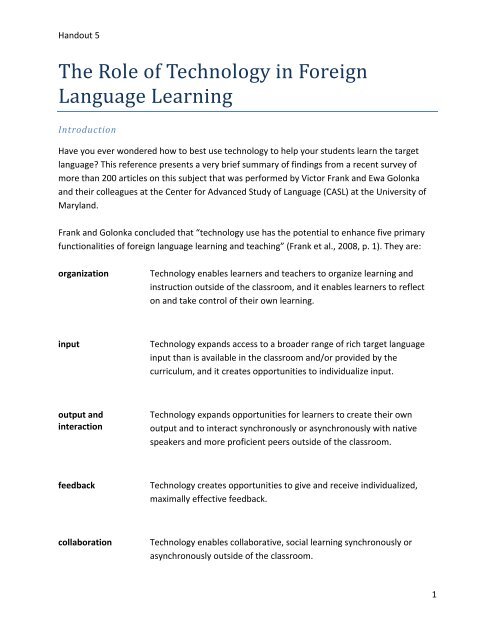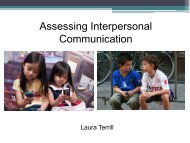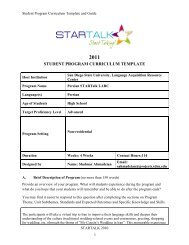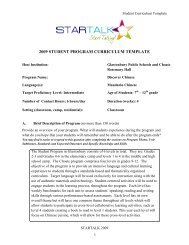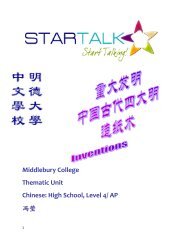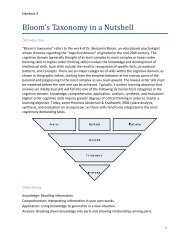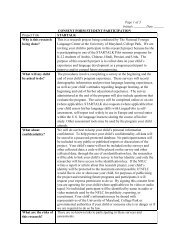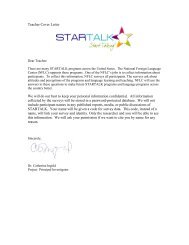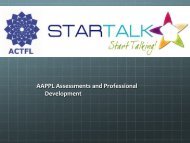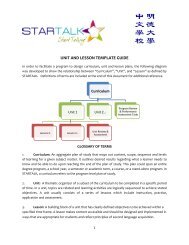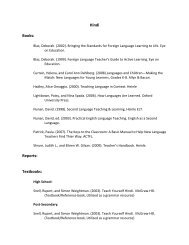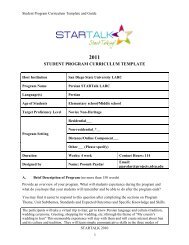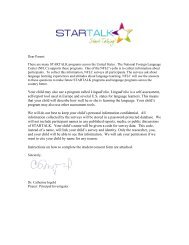The Role of Technology in Foreign Language Learning - StarTalk
The Role of Technology in Foreign Language Learning - StarTalk
The Role of Technology in Foreign Language Learning - StarTalk
Create successful ePaper yourself
Turn your PDF publications into a flip-book with our unique Google optimized e-Paper software.
Handout 5<br />
<strong>The</strong> <strong>Role</strong> <strong>of</strong> <strong>Technology</strong> <strong>in</strong> <strong>Foreign</strong><br />
<strong>Language</strong> Learn<strong>in</strong>g<br />
Introduction<br />
Have you ever wondered how to best use technology to help your students learn the target<br />
language This reference presents a very brief summary <strong>of</strong> f<strong>in</strong>d<strong>in</strong>gs from a recent survey <strong>of</strong><br />
more than 200 articles on this subject that was performed by Victor Frank and Ewa Golonka<br />
and their colleagues at the Center for Advanced Study <strong>of</strong> <strong>Language</strong> (CASL) at the University <strong>of</strong><br />
Maryland.<br />
Frank and Golonka concluded that “technology use has the potential to enhance five primary<br />
functionalities <strong>of</strong> foreign language learn<strong>in</strong>g and teach<strong>in</strong>g” (Frank et al., 2008, p. 1). <strong>The</strong>y are:<br />
organization<br />
<strong>Technology</strong> enables learners and teachers to organize learn<strong>in</strong>g and<br />
<strong>in</strong>struction outside <strong>of</strong> the classroom, and it enables learners to reflect<br />
on and take control <strong>of</strong> their own learn<strong>in</strong>g.<br />
<strong>in</strong>put<br />
<strong>Technology</strong> expands access to a broader range <strong>of</strong> rich target language<br />
<strong>in</strong>put than is available <strong>in</strong> the classroom and/or provided by the<br />
curriculum, and it creates opportunities to <strong>in</strong>dividualize <strong>in</strong>put.<br />
output and<br />
<strong>in</strong>teraction<br />
<strong>Technology</strong> expands opportunities for learners to create their own<br />
output and to <strong>in</strong>teract synchronously or asynchronously with native<br />
speakers and more pr<strong>of</strong>icient peers outside <strong>of</strong> the classroom.<br />
feedback<br />
<strong>Technology</strong> creates opportunities to give and receive <strong>in</strong>dividualized,<br />
maximally effective feedback.<br />
collaboration<br />
<strong>Technology</strong> enables collaborative, social learn<strong>in</strong>g synchronously or<br />
asynchronously outside <strong>of</strong> the classroom.<br />
1
Handout 5<br />
Best Practices for <strong>Technology</strong> Use <strong>in</strong> the Classroom<br />
Frank et al. (2008) also summarized best practices for us<strong>in</strong>g technology <strong>in</strong> a foreign language<br />
classroom related to the functionalities listed above. <strong>The</strong> follow<strong>in</strong>g table provides a summary <strong>of</strong><br />
best practices, with the desired outcomes <strong>in</strong> the left‐hand column and the suggested<br />
technology <strong>in</strong> the right‐hand column.<br />
In order to…<br />
maximize target language practice<br />
maximize the efficiency <strong>of</strong> classroom contact<br />
time with the teacher<br />
enable customization, shareability, reusability,<br />
and anytime/anywhere access to target<br />
language content and <strong>in</strong>structional materials<br />
archive and analyze <strong>in</strong>teraction, learner<br />
output, and <strong>in</strong>corporation <strong>of</strong> feedback, and to<br />
<strong>in</strong>dividualize subsequent <strong>in</strong>put and feedback<br />
motivate students and engage them <strong>in</strong><br />
mean<strong>in</strong>gful target language use<br />
Use technologies such as…<br />
written chat, outside the classroom<br />
computer‐assisted pronunciation tra<strong>in</strong><strong>in</strong>g,<br />
outside <strong>of</strong> the classroom<br />
course management systems, natural<br />
language process<strong>in</strong>g tools, and mobile devices<br />
<strong>in</strong>telligent tutor<strong>in</strong>g systems, ePortfolios, and<br />
natural language process<strong>in</strong>g tools<br />
ad hoc networks and serious games<br />
Adapted from Frank et al., 2008, Table 1, p. 2.<br />
References<br />
Frank, V., Golonka, E., Bowles, A., Becker, E., Freynick, S., & Richardson, D. (2008). Optimal<br />
foreign language learn<strong>in</strong>g: <strong>The</strong> role <strong>of</strong> technology. College Park, MD: Center for<br />
Advanced Study <strong>of</strong> <strong>Language</strong> at the University <strong>of</strong> Maryland.<br />
2


